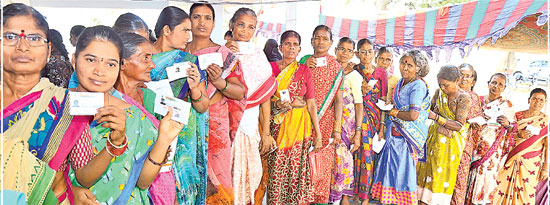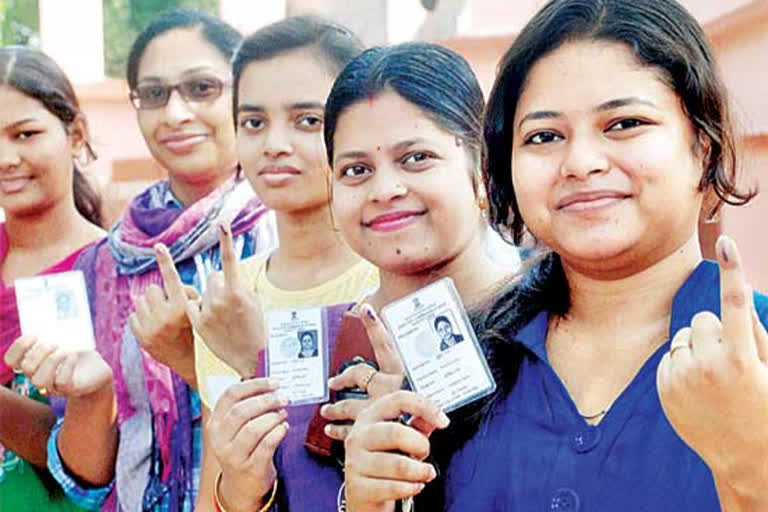Hyderabad: The participation of women voters in Indian elections has increased over the past few years. According to the Election Commission of India statistics, 67.2 percent of male voters had cast their vote in the 2019 general elections while the female voter turnout was 67 percent, closing the gap for the first time in decades. Further, women played a big part in the outcome of recent the Bihar polls and 2016 Tamil Nadu Assembly elections, turning the tables in favour of Nitish Kumar and Jayalalithaa. In both states, women exercised their vote in large numbers in Lok Sabha elections too. Even before 2019, female voters outnumbered their male counterparts in two-thirds of the states.

In the 2004 general elections, male voter turnout was 8.2 percent higher. In 2014, the percentage shrunk to 1.8. By 2019, the female and male voting percentages were on equal standing. With increasing literacy and financial independence, women are becoming more politically aware. Women self-help groups are nurturing the political ambitions of their members. Reserved constituencies, creating a safe environment during elections and making special arrangements for them at polling booths are all driving women voters to cast their vote.
Under-representation in key positions
In this context, there is a growing interest about the role of women voters in the upcoming Assembly elections. Only one of the 5 states that are going for polls has a female Chief Minister i.e. in West Bengal. In the 2019 Lok Sabha elections, female voting percentage has outnumbered male turnout in West Bengal and Kerala. The key question here is how the results would be if the same pattern repeated in the upcoming Assembly elections. Despite opposition to the Nitish Kumar government in Bihar, analysts said that he won thanks to the women voters who benefited from his welfare schemes. Nitish announced liquor ban in 2015 thereby winning over women. Like Bihar; Tamil Nadu and West Bengal have promised a wide range of welfare schemes for women. We must wait to see in whose favour the tables will turn.
Also read: Despite high social standing, women are a scant in NE politics
Pushed to the backburner in politics
Even though women are on par with men in terms of voter turnout; their number is abysmally low in political positions. Be it Gram Panchayat or Lok Sabha, the number of female political representatives can be counted on fingers. Women are lagging behind in key political campaigns and delegation of work to their political subordinates. Even if some women came forward in this difficult arena, the deep-rooted patriarchy is pulling them back. The stress of household chores and childcare is becoming a hurdle to their development. Even the women elected to local bodies merely play to the tune of their husbands or fathers. Women are as capable as men in leading a village or a country. India had a female Prime Minister long before any of the developed countries. Women leaders in Sri Lanka, Israel and Bangladesh are setting an example to the world.
While the influence of women on election outcome is evident, they are not playing a proactive role as leaders. Only 14 percent of the Lok Sabha representatives are women. Nearly half of them are elected from 4 states alone. Women constitute 9 percent of Legislative Assemblies. In a study conducted by the World Economic Forum about the representation of women in Parliament, India ranked 122 out of 153 nations. Women are getting better representation in local bodies than in Assemblies and Parliament. This was the result of 73rd amendment to the Constitution that mandated reserving one-third of the seats for women in local bodies.
Also read: Army's evaluation criteria for PC to women SSC officers shows systemic discrimination: SC
The majority of women elected to Assemblies and Parliament hail from influential families. 42 percent of women elected to Parliament belong to powerful political families. There are no reservations for women at the parliamentary level. Since men cannot compete for reserved constituencies, they are nudging women in their families to contest instead. Women from affluent families who can afford campaigning expenses alone are benefiting from this provision.
The world looks towards women
Nations led by women namely New Zealand, Taiwan and Germany have shown unprecedented response to the COVID-19 pandemic. Even in the US, states led by female governors have recorded the lowest number of mortalities. Female policymakers have achieved better results in terms of education, health and prevention of crimes compared to their male counterparts. Though reservations in local body elections empower women, we can ensure their better success only when religious and cultural barriers are done away with.
The Parliament must approve the long-pending Women’s Reservation Bill 2008. If arrived at a consensus, one-third of all seats in Parliament and state legislative assemblies must be reserved for women. In addition, there is a proposal to reserve 50 percent of Chief Minister posts for women. As Assam, West Bengal, Kerala, Tamil Nadu and Puducherry are gearing up for elections between March 27 and April 29; there is a need to discuss gender disparity in Indian politics.
Also read: India witnessed major rise in domestic violence during pandemic: NCW
The Generation Equality Forum, a global gathering for gender equality, begins on March 29 in Mexico City and will conclude on June 21 in Paris. Convened by UN Women and co-hosted by the governments of Mexico and France; the meetings will discuss women leadership, women’s rights activism and feminist solidarity. In this context, the results of Indian Assembly elections will no doubt attract the world’s attention.



